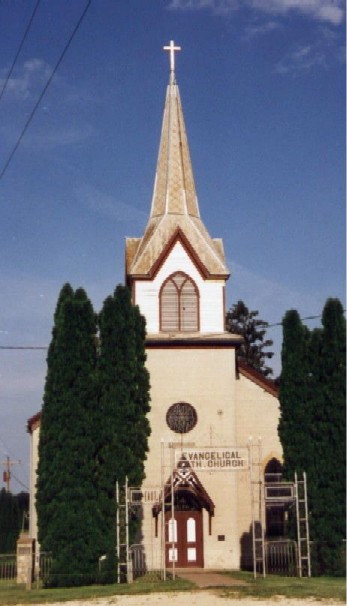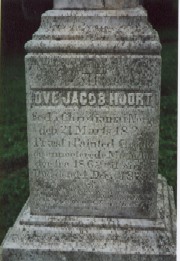updated 07/02/2015
![]()
updated 07/02/2015
Old East Paint Creek Evangelical Lutheran Church |
Lutheran Church rural Waterville. The
parent church was est. ca 1852 when the
Norwegian settlers first came to Paint Creek area in Allamakee
Co.

 Gravestone of Rev. Ove Jacob Hjort, an early OEPC pastor |
 The historical marker at OEPC |
History of Old East Paint Creek Church
“Just a little country church atop the ridge between the
valleys of Paint Creek and Village Creek”....
An early meeting, occurring in the fall of 1850, addressed the need for a Christian school and a place to worship with the arrival of these first Norwegian settlers to the Paint Creek area. The first recorded meeting was January 06, 1851. In March 1851 a meeting took place to organize a school district with Ole Larson as the first school teacher. Known as the Dalby schoolhouse, it was built and in use by November 1851. It was used for Church services, as well. The May 1852 record shows the first installment payment on 80 acres of land which had been placed in a land warrant for the congregation.
The first services were held July 1851 at the home of Thomas Anderson {aka Gronna}. Pastor C. L. Clausen, who was then located at Rock Prairie, WI, conducted these services. He traveled throughout Wisconsin and Iowa performing baptisms and marriages. The next pastor to visit Paint Creek was Pastor Nils Brandt. He traveled between Rock Prairie, WI and Paint Creek, Iowa from 1851 through 1853. The congregation sent a Letter of Call to Norway requesting a permanent pastor. The Rev. Ulrik Velhelm Koren answered the call arriving to preach New Year’s Day, 1854. A meeting in July 1855 determined the need to build a church which was taken into use prior to June 1857. Pastor Koren served until May 1862 when he returned to Norway. On February 05, 1859, it was decided to build a parsonage, however, it was not needed until July 1862 when Pastor O. J. Hjort arrived with his family.
Rev. Ove Jacob Hjort graduated from the Seminary at St. Louis, Missouri and became the first resident Pastor for the congregation in July 1862. The congregation had grown and divided into two churches, East and West. The cornerstone for the current ‘rock’ church, Old East Paint Creek, is dated May 24, 1869 and was dedicated August 24, 1870 with an estimated 1400 to 1500 people present. Pastor O. J. Hjort served until his death December 14, 1879 and is buried in OEPC Cemetery with his 1st wife, Christiane Elizabeth and 2nd wife, Henriette. An assistant Pastor, C. C. Stolz, served until Rev. H. A. Hartmann accepted the call in September 1880. Pastor Hartmann returned to Norway in 1895 where he served until his death in 1925. His first wife, Aagot, is buried at OEPC Cemetery.
Predestination controversy raged among the Norwegian Lutherans during 1880 and the Paint Creek congregations were not spared. A small minority broke away from the original two churches organizing their own congregations in 1887 having refused to become part of the Evangelical Church. They are known as the East and West Synod Lutheran churches.
To distinguish between the two original churches the prefix word ‘Old’ was added to the names
‘Old East Paint Creek and Old West Paint Creek Churches’
The Ladie’s Aid Society, “Kvindeforening,” of Old East Paint Creek was organized at the parsonage on January 15, 1886 by Mrs. Aagot Hartmann and Miss Tonning.
The next Pastor to serve the Old East and Old West congregations was Pastor C. J. M. Gronlid in May 1895. He served for 25 years until May 1921. He is buried in OEPC Cemetery. Pastor Joseph E. Lee served as an assistant from 1918-1920. Pastor A. P. Lea was called and began his work in 1920 resigning in the spring of 1941. He died in September 1950 and is buried at OEPC Cemetery.
A Letter of call was sent to Pastor Elmo O. Baalson and he was installed on February 08, 1942 serving until 1975. Pastor Paul H. Tobiason served from 1975 until 1983. Reverends April Urling Larson, Judd Larson, and Gary Bachman served the congregation between 1983-1994. August 01, 1994, Pastor Kenneth Kimball answered the call and is the current Pastor.
A number of members of the congregation entered the ministry:
Wilhelm Magnus Herman Peterson, Kaspar Gl Faegre, Christopher Pederson, Ellef Olson, Oluf Hanson Smeby, Marcus K. Hartmann, Hartvig K. Narum, Hjalmer O. Gronlid, Isaak R. Gronlid, Tennis H. Megordon, the first pastor to be ordained at Old East Paint Creek was Clarence Baalson, and David Sorenson
~*~
~source of the history - OEPC church booklet: "A History, On the Occasion of the, One Hundred Fiftieth Anniversary, 1850-2000,
Old East Paint Creek Lutheran Church, Waterville, Iowa" compiled by the congregation in 1950 and rewritten in 2000; excerpts by Sue Kenyon; beginning quote by Pastor Kenneth Kimball
~photos by Sue Kenyon
~contributed by Sue Kenyon for Allamakee co. IAGenWeb
~*~*~
Old East Paint Marks 130th Year
by Elnora J. Robey
Waterville - An unknown Prairie du Chien ferryman may be responsible for formation of what could be the oldest Norwegian Lutheran congregation in Iowa. Old East Paint Creek Church, located 10 miles east of Waukon, will celebrate it 130th anniversary next weekend.
In October 1849, immigrants Svend Hesla, Ole Larson, Nils T. Roe and Ole Storla walked from the Norwegian settlement of Koshkonong, near Rock Prairie, Wis., to Prairie du Chien, where they asked to be taken on the horse-treadled ferry to the Turkey River.
The ferryman convinced them there was no more good land in the Norwegian settlement on the Turkey River, but there was plenty north of there. He left them at the mouth of a creek they later called "Painted," then "Paint." They followed an Indian path as far as Big Spring, now Waukon, but thought it was too far from the Mississippi and too close to level land. Going back about 10 miles, each claimed a spring in hilly land before returning to Koshkonong.
In May, eight men came to the area, some with their families. Two more groups came in 1840 (sic), establishing a total of 24 homes.
Unlike Iowa's earliest Norwegian colony at Keokuk, which had a predominance of Quakers, Mormons and Liberals (according to a historical study by I.R. Gronlid in 1928), or the Turkey River group, which met informally for services, the immigrants from Hallingdal, Norway, organized a congregation almost at once.
Old East has the original minute book, though the first page has disappeared. An entry dated Jan. 6, 1851, says, "At the meeting of the trustees today, J.L. Moller was appointed the secretary, as elected at the last meeting of the congregation."
Two months later, the congregation organized a school district and unanimously voted to build a school on land the congregation owned. The building was to be used as a meeting place and church. The bought 80 acres, which must have seemed a vast area to some of the early Norwegian settlers. That land is still church property. The Rev. Paul Tobiason, pastor since 1975, is the first who has not farmed the land.
Tobiason, a native of Scotch Grove, attended Luther College and graduated from Luther Seminary in St. Paul in 1968. He was assistant pastor at St. John Lutheran Church in LeMars and pastor at Messiah Lutheran, Janesville, before coming to Old East and Old West churches, which have more than 200 confirmed members each.
Until 1854, the congregation had only visiting ministers. Then for eight years it shared the Rev. Ulrik Vilhelm Koren with Washington Prairie Church in Winneshiek County. July 15, 1855, immediately after voting to build a church, the congregation took up a collection, raising $27.87 at that meeting. The 30-by-24-foot log building was already outgrown by the time it was completed that fall. In May 1858, the people voted to split into east and west congregations with a common pastor, parsonage and farm. The following February, they voted to build a parsonage. But it was four more years before the Rev. Ove Jacob Hjort became their resident pastor.
Hjort remained until his death in 1879, although the Rev. C.C. Stoltz had charge of his five congregations (East, West, Lansing, New Albin and Faegre Prairie) from 1878 to 1880. In those days, a multiple pastorate meant churches didn't have the pastor every Sunday. Even the Rev. Anton Lea (1920-1941) was a Old East and Old West on alternate Sundays. However, services were conducted under the guidance of lay-men.
One of Old East's remembered lay religious teachers was I.O. Johnson, who began a 50-year service to the parish in 1869. During the early decades, children attended the church school for nine months. After they began attending public schools, pupils of each school district attended two months of summer church school taught by students from Luther and St. Olaf colleges. Usually these were young people of the congregation, including seven of Lea's sons and daughters. The modern Sunday school was organized by the Rev. Elmo Baalson (1942-75)
During the pastorate of the Rev. H.A. Hartman (1880-95), a controversy about predestination shook Lutheran congregations, and a minority broke away from the Paint Creek churches to form what are now the East and West Synod Lutheran churches. Since that schism, the Paint Creek churches have been called Old East and Old West.
Besides being a stable community, with many descendants of the original families still living in the area, Old East has had remarkably few pastors - only eight in all. Besides those mentioned, there was the Rev. C.J.M. Granlid (1895-1920), one of three pastors buried in the church cemetery.
The present stone church was built in 1870. The exterior was plastered in 1906. The first parsonage burned and was replaced by an eight-room house in the 1880s. This was enlarged in 1898 and completely remodeled in 1942. A major acquisition was the Wurlitzer pipe organ, purchased from a Chicago theater in 1944.
~Cedar Rapids Gazette, Saturday, June 14, 1980 (included the small photo)
~transcribed by S. Ferrall for Allamakee co. IAGenWeb